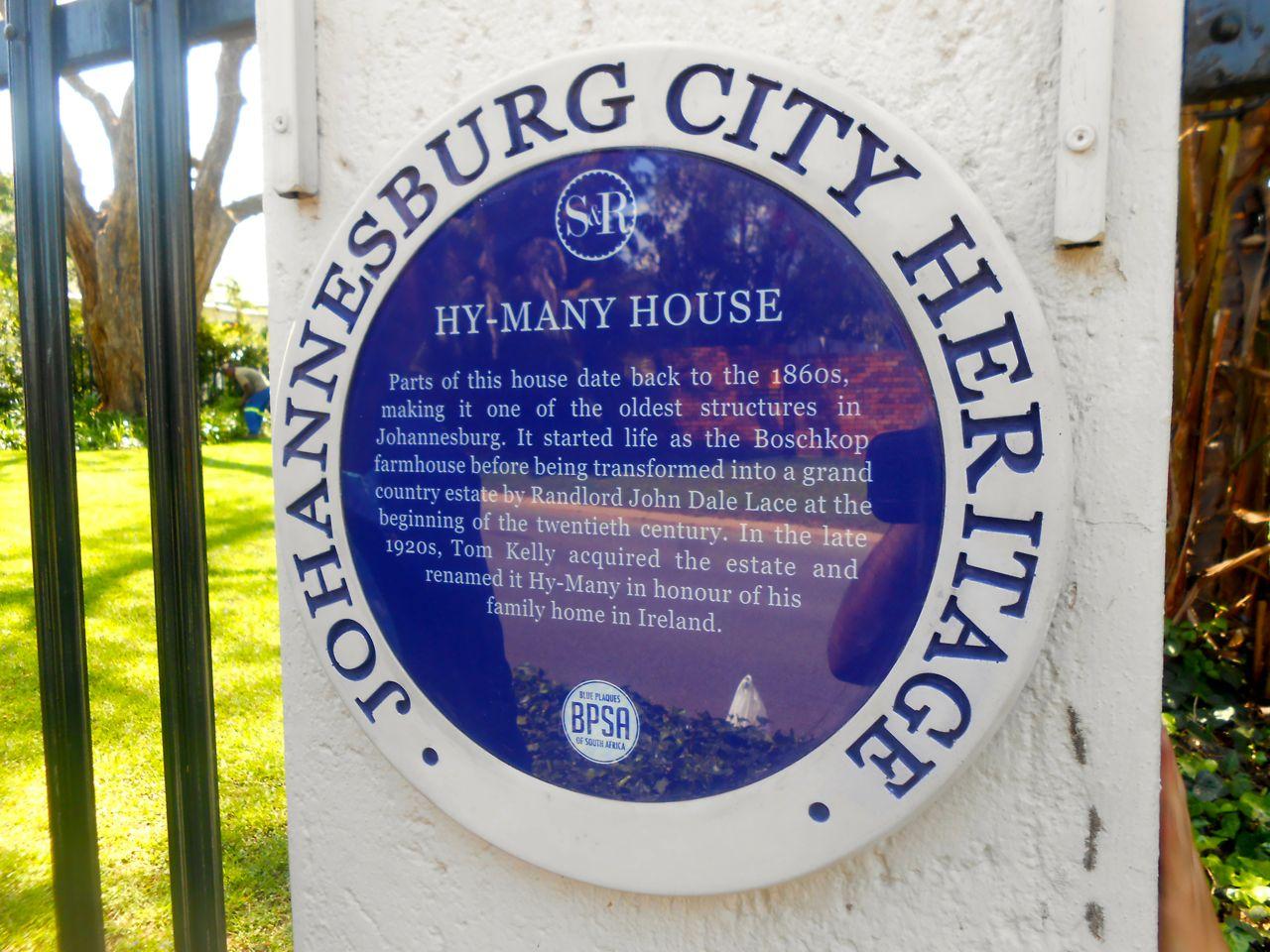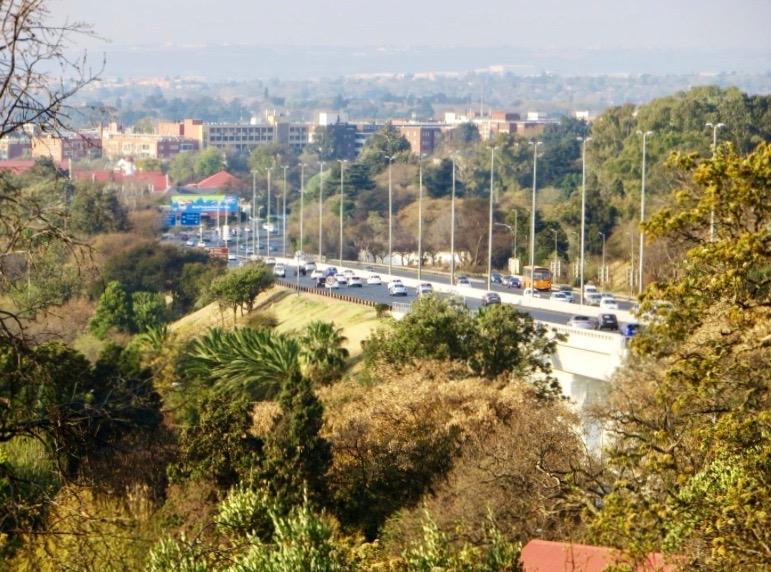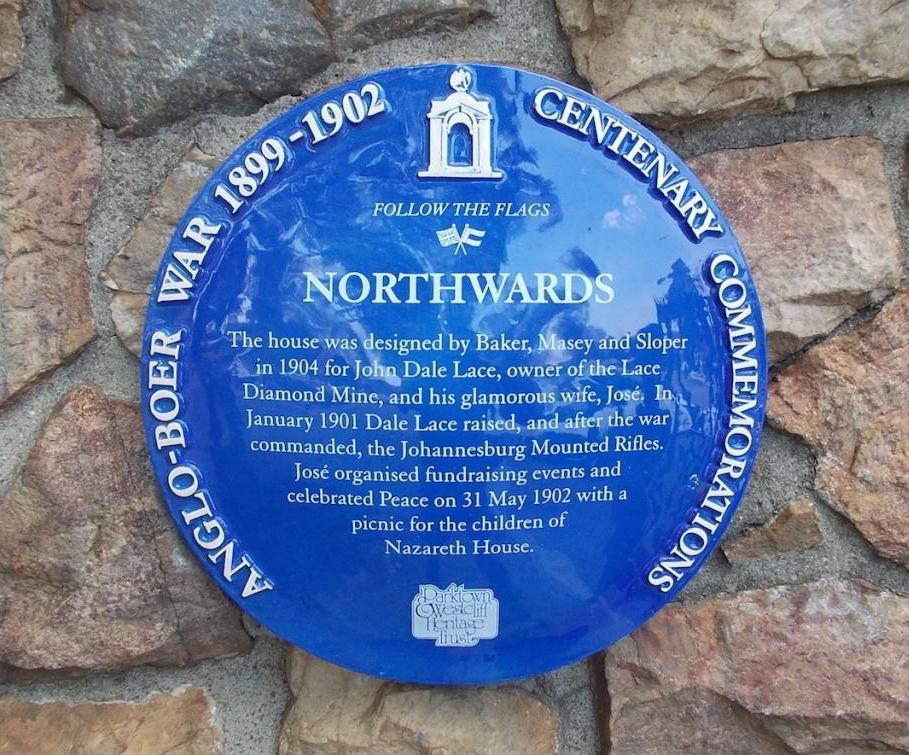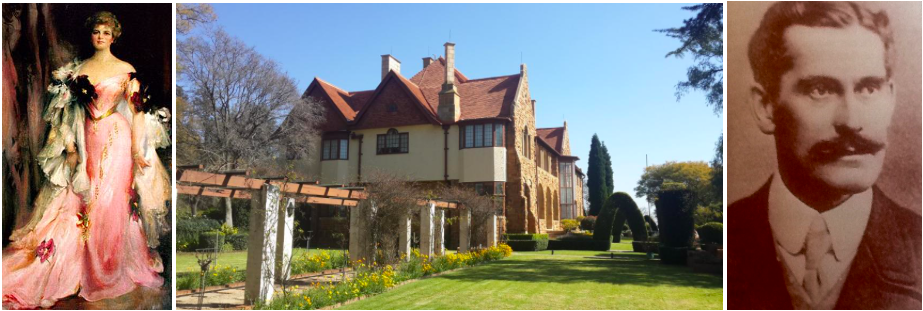
Dr Pam Heller-Stern has written a novel based on the life and times of Jose Dale Lace, grand dame of Edwardian Johannesburg. Married to John Dale Lace, the couple commissioned the architect Herbert Baker to build them a grand mansion on the Parktown Ridge. Completed in 1904, Northwards was one of the most imposing and enduring of the mansions of Parktown. Jose Dale Lace is best associated with Northwards. She was the flamboyant, wild, socialite with ambitions above her fairly modest Cape origins. Jose and John lived there until 1911 when a disastrous fire destroyed their home, their finances and their dreams. The Albu family bought the ruin and rebuilt and restored it.
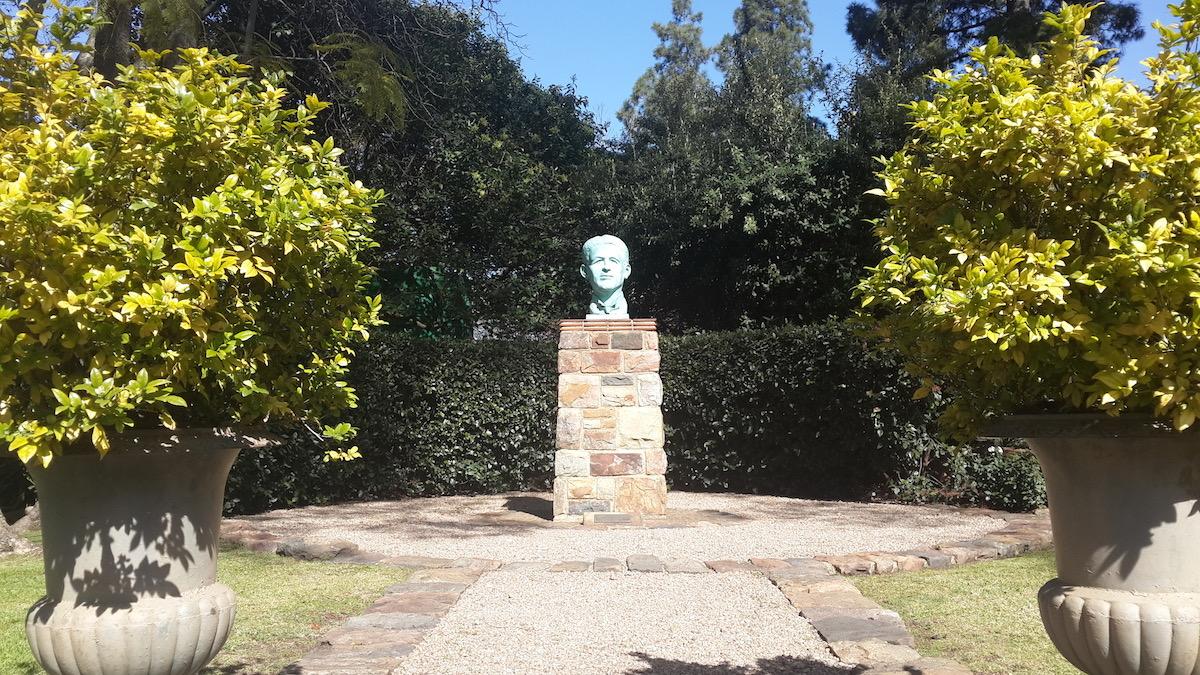
Herbert Baker bust at Northwards (The Heritage Portal)
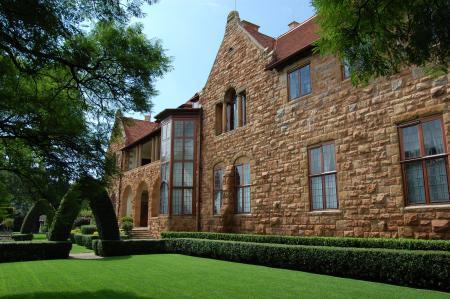
Northwards (The Heritage Portal)
It is not an easy task for an author who writes fiction but uses history as the source material to tell a believable story. Historical novels are often frivolous figments of imagination and the author is free to take liberties with facts. I think this book falls between biography and fiction. Research may be extensive but the author has the space to pick and choose from the past to create mood and imagery. Pam Heller-Stern is an English scholar and not an historian so this book although evidently based on wide historical reading gives only a few source references, has no footnotes, no index and appears to invent letters. The closest we have to a biography is Daphne Saul’s Bird of Paradise (click here to read a review on The Heritage Portal) and the stories of Dale Lace and Northwards have been told in the Parktown Collection set of pamphlets. Daphne Saul drew heavily on the material gathered by Thelma Gutsche but Thelma did not live to write the biography. Currently Neil Viljoen is researching and writing the biography of Jose Dale Lace. We all eagerly await that book! A biography of John Dale Lace would also add to Johannesburg history.
Everyone appears to be fascinated by Jose Dale Lace and Pam subtexts her book 'A Woman of Some Importance'. I think whether Jose Dale Lace was of some or of no importance is worth exploring, but to do that requires more analysis of late Victorian and early 20th century English and colonial South African society and getting into real social history. Jose Dale Lace was born in 1869 in the Victorian era. She came from Richmond in the Cape. Her family was not nearly as distinguished or affluent as she would have liked. She was fortunate enough to be chaperoned and introduced to London and English society as a teenager by Lady Emma Mills, wife of Sir Charles Mills the Cape Agent General (not Colonial Agent as mentioned in the book). Jose attended a small private school for four years, Catherine Lodge. She grew into a wilful, independent minded beauty who clearly chaffed against the conventions and social mores of the day where on the surface women married as a career, but beauty was a saleable asset to make a “good” match. Good looks could be traded for a place in society either as a wife of a titled earl or as a mistress but coming out and being received as a debutante and presented to Queen Victoria in such high society meant observing the rules. If you became a mistress of an aristocrat and depended on such men for your rent, your dress allowance and your sustenance you could hardly expect to be a welcome guest in the great houses of Mayfair. Jose certainly acquired the veneer and sufficient social surface knowledge to keep a grand house and organize servants, gardens, carriages and horses.
Jose became the mistress of Ernest Beckett (born Beckett Dennison) a banker and MP from Yorkshire who later inherited a title from an uncle and became the 2nd Baron Grimthorpe. There is sufficient information to show that these facts can't be disputed but what happened was swept under the drawing room carpet. She was his mistress before his wife died and he had promised marriage if and when she died. The wife, an American heiress Lucy Tracy Lee (named Luie), conveniently but sadly died following the birth of a son. Beckett was both an art collector (of some distinction it would appear from the British National Gallery’s online biographical entry) but also a cad. He did not marry his Jose. With boundless self-confidence, and ever resilient, Jose took to the profession of acting in London and performed in an Oscar Wilde play, A Woman of No Importance (hence the sub-title of this book). She then married John Dale Lace who was a Manxman who made his name initially as a banker in South Africa before getting involved in minerals and mining. Besotted with Jose, he returned to the Witwatersrand. Beckett reappears on the scene and now proposed; Jose appeals to John Lace for a divorce; John agrees and a divorce goes through and although Jose resumed her relationship with Beckett and fell pregnant (the child grew up under the name Lancelot Dale Lace and served with distinction in World War I winning an MC only to be lost in World War II), Beckett did not marry her. A cad above all else; for Jose it was back to John Dale Lace and remarriage. All of this is the stuff of a romantic Mills and Boon story and Pam fictionalises the story to sustain the interest of the reader. She appears to draw heavily on Daphne Saul’s Bird of Paradise with little to no precise acknowledgement.
Ernest William Beckett (Spy Cartoon)
John Dale Lace
However, I prefer rather more solidly based biography. These characters are worth researching properly and with care and with accurate dates, time sequences and source notes. John Dale Lace had full page coverage in Men of the Times (1905). The biographical sketch has the feel of an advertorial, with John Dale Lace described as “the most popular man on the Rand today”. He was described as a pioneer of gold mining who gave up banking and made his fortune in gold, coal and base metals. He also had an interest in diamonds, establishing the Lace Diamond Mining Company (25 miles from Kroonstad in the Free State - and still in existence though talked about in current mining newspapers as a “dog”). Lace was one of the plotters on the Reform Committee and served three months in Pretoria gaol for his part in the Jameson Raid. In her account, Heller-Stern places all blame for the failure of the Jameson Raid on Jameson. In my view that is too simplistic a cop out for the Reform Committee. Move on in time and the Lace couple, adopting the rather grander name Dale Lace are back in Johannesburg and making their way in society. According to the Men of the Times sketch Lace should have been the first Mayor of Johannesburg but his ambitions were displaced by party intrigues (what might that mean?). John Dale Lace was president of the local Manx society. Here is a seam that could have been explored. These local English and Scottish societies in Johannesburg were anchors in a very raw new town. John stood in the first elections for the Transvaal responsible government for Clifton and was defeated. That put paid to Lace’s political ambitions. Added to political defeat came financial collapse. His story of business, banking and mining entrepreneurship is the one that needs exploring - he was a man of some importance and rose and fell to become a man with a promising future behind him.
Today we can enjoy Northwards and place ourselves in the spacious drawing and reception rooms with the magnificent portrait of Jose (by Hal Hurst) looking down on us at the JHF lectures. The portrait was found and restored to its rightful place by Thelma Gutsche. It is a lovely Edwardian society portrait - the bare shouldered figure billowing in pink fantasy light fabric. It is just the sort of portrait one sees in London galleries or at the Getty Centre in Los Angeles. It is a period piece. Unfortunately it is the only picture in this book - there is no photo of Northwards or of the country home of the Dale Laces, Boschkop (now Hy-Many House with a blue plaque). There is no photo of Lord Grimthorpe, or Lance Dale Lace and so much more. I know there are photographs out there. Otterley Press, a well known private press are the publishers and I think they have a responsibility to advise the author to look for photographs.
The famous portrait of Jose
Hy-Many House Blue Plaque (The Heritage Portal)
Hy-Many House
Back to Northwards. The smaller reception room of Northwards has some informative display boards explaining the history of the house and the people who lived here. The view from the upper open veranda at first floor level is the best place to get the grandest of views to the north to the Magaliesberg and across the well treed suburbs of Forestown, Parktown and Saxonwold. The gardens below are superbly laid out and today are cared for by the Northwards Trust. Northwards is part of the Knockando residence of the University of the Witwatersrand and the expanse of the acres of gardens of the original mansion have shrunk through the intrusion of the M1 motorway and sacrificed to the construction of more recent university residences. But Northwards remains, a house with a blue plaque (to be seen at the entrance gates on Rockridge Road) and the old National Monuments Council bronze plaque within the entrance porch at the front door. This is where you will find the office of Johannesburg Heritage Foundation and get close to reliving the Edwardian lifestyle of the rich and famous. Incidentally there is a 1907 now rare map of the Clifton constituency fought for by John Dale Lace in an upstairs room. There is an excellent article by Albrecht Holm on The Heritage Portal (click here to read) and a recent JHF tour of four of the ridges of the Witwatersrand included Northwards. Neil Viljoen always graciously welcomes pre-booked guests. I wrote up the tour for the Heritage Portal (click here to read).
The intrusion of the M1 motorway (Kathy Munro)
Northwards Blue Plaque (The Heritage Portal)
Pam was attracted to the story of Jose Dale Lace when she was commissioned to visit and write about Hotel Villa Cimbrone in Ravello on the Amalfi coast of Italy. Her piece was a travelogue and full marks for making the connections and developing the theme of this novel. Cimbrone had been the home of Ernest William Beckett, 2nd Lord Grimthorpe. Now a hotel it was a beautiful estate with some fine art works collected by Beckett. He died in 1917 and the property remained in the family with his legitimate daughter Lucille taking up residence.
This novel gets behind the facts and uses imagination and style to tell the story of the rise of Jose Dale Lace and of London and Johannesburg la belle époque, high society and her marriage to John Dale Lace of Johannesburg. This romantic and ultimately sad tale of silly romantic excess, social success, financial cornucopia but then financial collapse, facing failure, and even a shipwreck on the Galway Castle and then rising above catastrophe with grit and determination has been told with verve. I suppose the sense of sheer zest for life and guts for survival makes Jose an interesting subject. I think the psychology of such a woman could be worth exploring - did Jose not suffer from delusional fantasies with trying to spin the story of an affair with Edward VII and hinting that her son was actually fathered by the King? Did she not suffer from an excessive ego - was this a classic case of a narcissistic personality disorder?
Often fact is stranger than fiction and Pam has missed one quintessential Johannesburg story. There is a link between the beautiful sculpture by Rodin, the masterpiece owned by the Johannesburg Art Gallery, Miss Fairfax and Jose Dale Lace. Eve Fairfax was engaged to the same Lord Grimthorpe who had had his fun with Jose just a few years earlier. I wrote the story of Eve Fairfax and the Miss Fairfax bust for The Heritage Portal (click here to read). Ernest Beckett commissioned Rodin to sculpt the bust of Eve Fairfax. The engagement was broken off, Rodin was never paid. Eve meanwhile had become a friend of Rodin and he gave her the gift of the marble bust. Eve never married and several years later when Hugh Lane formed the collection for the new Johannesburg Art Gallery, financed by Lady Florence Phillips, the bust was purchased by Lane for Johannesburg. How extraordinary that both the Hal Hurst portrait of Jose Dale Lace at Northwards and the Miss Fairfax Rodin bust at the Johannesburg Art Gallery should be connected through a philandering English aristocrat. Surely that story would add lashings of cream for a novelist, who clearly enjoys writing novels about society women of early Johannesburg.
Eve Fairfax marble bust in the Johannesburg Art Gallery
Pam Heller-Stern holds a doctorate in English Literature and has written several novels. The advantage of a well-written novel is that the writing carries the story forward; it’s an easy entertaining read where imagination fills the gaps – but I found it hard to separate fact from fiction. However, this is not a biography or a work of scholarship; dates as to precisely when things happened or care with chronological sequences are secondary to the storyline. My own preference is for proper footnotes or endnotes, an index and a full bibliography. I have spotted a couple of errors. For example, there is no longer a Johannesburg College of Education and Northwards is located on the Knockando residential complex of the University of the Witwatersrand; the word automobile was the term used for a motor car in 1900; the Johannesburg architects were W Leck and F Emley not Leck and Emsley (see the easily sourced online entry in Artefacts). It would be tedious and churlish to pick out more problems in the loose use of facts.
I congratulate Pam on writing a novel that will add to Johannesburg's background and the city’s literature. It is a book worth acquiring for an entertaining read. I am anxious though that many readers will take this novel as history. I hope that it will raise an interest in heritage among new enthusiasts and that we soon see some well researched history of the type that Charles Van Onselen writes and has set as a high bar for fellow historians.
2019 Price Guide: R230 if ordered and purchased from the JHF office at Northwards.
Kathy Munro is an Honorary Associate Professor in the School of Architecture and Planning at the University of the Witwatersrand and chair of the Johannesburg Heritage Foundation. She enjoyed a long career as an academic and in management at Wits University. She trained as an economic historian. She is an enthusiastic book person and has built her own somewhat eclectic book collection over 40 years. Her interests cover Africana, Johannesburg history, history, art history, travel, business and banking histories. She researches and writes on historical architecture and heritage matters. She is a member of the Board of the Johannesburg Heritage Foundation and is a docent at the Wits Arts Museum. She is currently working on a couple of projects on Johannesburg architects and is researching South African architects, war cemeteries and memorials. Kathy is a member of the online book community the Library thing and recommends this cataloging website and worldwide network as a book lover's haven.

